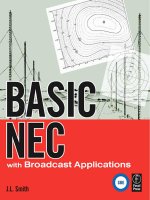Focal press the service oriented media enterprise SOA BPM and web services in professional media systems mar 2008 ISBN 0240809777 pdf
Bạn đang xem bản rút gọn của tài liệu. Xem và tải ngay bản đầy đủ của tài liệu tại đây (5.68 MB, 545 trang )
The Service-Oriented
Media Enterprise
This page intentionally left blank
The Service-Oriented
Media Enterprise: SOA,
BPM, and Web Services in
Professional Media Systems
John Footen
Joey Faust
AMSTERDAM • BOSTON • HEIDELBERG • LONDON • NEW YORK
• OXFORD • PARIS • SAN DIEGO • SAN FRANCISCO • SINGAPORE
• SYDNEY • TOKYO
Focal Press is an imprint of Elsevier
Acquisitions Editor: Angelina Ward
Publishing Services Manager: George Morrison
Project Manager: Mónica González de Mendoza
Assistant Editor: Kathryn Spencer
Design Direction: Joanne Blank
Cover Design: Maria Mann
Cover Images © iStockphoto
Illustrations: Joey Faust
Focal Press is an imprint of Elsevier
30 Corporate Drive, Suite 400, Burlington, MA 01803, USA
Linacre House, Jordan Hill, Oxford OX2 8DP, UK
Copyright © 2008 Elsevier, Inc. All rights reserved.
No part of this publication may be reproduced, stored in a retrieval system, or transmitted in any form
or by any means, electronic, mechanical, photocopying, recording, or otherwise, without the prior written
permission of the publisher.
Permissions may be sought directly from Elsevier’s Science & Technology Rights Department in Oxford,
UK: phone: (ϩ44) 1865 843830, fax: (ϩ44) 1865 853333, e-mail: You may also
complete your request online via the Elsevier homepage (), by selecting “Customer
Support” and then “Obtaining Permissions.”
Recognizing the importance of preserving what has been written, Elsevier prints its books on acid-free
paper whenever possible.
Library of Congress Cataloging-in-Publication Data
Footen, John.
The service-oriented media enterprise : SOA, BPM, and web services in professional media systems /
John Footen, Joey Faust.
p. cm.
Includes bibliographical references and index.
ISBN 978-0-240-80977-9 (pbk. : alk. paper) 1. Mass media—Economic aspects. 2. Mass media and
technology. I. Faust, Joey. II. Title.
P96.E25F665 2008
338.4Ј730223—dc22
2008000457
British Library Cataloguing-in-Publication Data
A catalogue record for this book is available from the British Library.
ISBN: 978-0-240-80977-9
For information on all Focal Press publications
visit our website at www.books.elsevier.com
08 09 10 11 12 13
10 9 8 7 6 5 4 3 2 1
Printed in the United States of America
DEDICATIONS
This book is dedicated to my children — Alexander, Danial, and John.
And, of course, to my always patient wife Sharin for her love and
support.
—John Footen
This book is dedicated to my family and friends, whom I have
neglected in order to ensure its completion.
—Joey Faust
This page intentionally left blank
TABLE OF CONTENTS
Acknowledgments
Introduction
xiii
xv
Chapter 1: Business and Technology Changes Driving the Service-Oriented
Media Enterprise
1
1.1 The Unpredictability of Change
2
1.2 New Distribution Platforms
5
1.2.1 Television
5
1.2.2 Motion Pictures
9
1.2.3 The Internet
11
1.2.4 Opportunities
15
1.3 Media Consolidation and Regulation
18
1.4 New Competition
21
1.5 Changing Audience
23
1.6 Increased Adoption of Information Technologies
24
1.7 Collaborative, File-Based Production
26
1.8 Increasing Automation Capabilities
30
1.9 Conclusion
32
Chapter 2: An Overview of Integration Techniques in the
Media Industry
35
2.1 The Benefits of Good Integration
35
2.2 What Is Integration?
39
2.3 Approaches to Integration
41
2.3.1 Vendor Verticals
43
2.3.2 Best-of-Breed Solutions
46
2.3.3 Custom Solutions
49
2.4 Commonly Used Integration Technologies
2.4.1 Transport Mechanisms
54
2.4.2 Protocols
56
53
vii
viii
TABLE OF CONTENTS
2.5 Accidental Architecture
2.6 Conclusion
63
57
Chapter 3: Service-Oriented Architecture: Definition, Concepts, and
Methodologies
65
3.1 Introduction
66
3.1.1 History of SOA
66
3.1.2 Adoption in Other Industries
70
3.1.3 SOA in a Nutshell
71
3.2 The Benefits of SOA
77
3.2.1 Business Agility
77
3.2.2 Visibility
83
3.2.3 Organizational Benefits
87
3.3 Services
93
3.3.1 Definition
93
3.3.2 Service Implementation Choices
101
3.3.3 Classes of Services
106
3.3.4 Service Decomposition
118
3.4 Wrappers
126
3.4.1 Wrapper Models
129
3.4.2 Common Wrapper Problems
134
3.4.3 Wrapper Governance and Planning
137
3.5 SOA Best Practices
138
3.5.1 Governance
138
3.5.2 Data Management
140
3.5.3 Service Policies
142
3.5.4 When It Is Okay to Tightly Couple
143
3.6 Conclusion
145
Chapter 4: Middleware
147
4.1 The Definition of Middleware
147
4.1.1 Middleware in SOA
148
4.1.2 Features and Components of Middleware
4.2 Application Servers
154
4.3 The Enterprise Service Bus
162
4.4 Other Middleware Components
168
4.5 What Middleware Is Not Good For
173
4.6 Middleware Best Practices
174
4.7 Conclusion
179
Chapter 5: Web Services
181
5.1 Why Web Services?
181
5.1.1 A Media Engineer’s Perspective
183
5.1.2 Important Characteristics
184
5.2 XML: Extensible Markup Language
186
5.2.1 The Benefits of Using XML
187
5.2.2 XML in Web Services
194
5.3 Web Services Roles
195
5.3.1 The Service Provider
196
150
ix
TABLE OF CONTENTS
5.4
5.5
5.6
5.7
5.3.2 The Service Consumer
198
5.3.3 The Service Registry
201
Web Services Standards
203
5.4.1 WSDL
204
5.4.2 SOAP
212
5.4.3 UDDI
220
5.4.4 Other Standards
231
Web Services Considerations
236
How Web Services Are Better Than Other
Communication Methods
240
Conclusion
245
Chapter 6: Business Process Management: Definitions, Concepts, and
Methodologies
249
6.1 The Benefits of Business Process Management
254
6.1.1 Agility
254
6.1.2 Visibility
258
6.1.3 Organizational Benefits of BPM
262
6.2 Workflow Analysis
265
6.2.1 Business Modeling and Simulation
266
6.2.2 The Ten Commandments of Workflow Analysis
270
6.3 Process Orchestration
278
6.3.1 The Process Layer
279
6.3.2 Architectural Considerations for Processes
281
6.3.3 Organizational Considerations in Processes
286
6.3.4 Standards
288
6.4 Conclusion
295
Chapter 7: What Is the Service-Oriented Media Enterprise?
297
7.1 Media Challenges and Ways to Deal with Them
300
7.1.1 Media Culture
301
7.1.2 The Size of Media
307
7.1.3 Time
310
7.1.4 Legacy Systems in Media
313
7.1.5 Codecs and Transcoding
314
7.1.6 Metadata
318
7.1.7 Reliability
320
7.1.8 Security
322
7.1.9 Exception Cases that Affect Integration
325
7.2 The Media Layer
330
7.2.1 Necessary Components of a Media Layer
332
7.2.2 A Service-Oriented Media Utopia
339
7.3 Conclusion
341
Chapter 8: Moving toward a Service-Oriented Media Enterprise
8.1 Before Beginning
349
8.2 The Big Picture
351
8.2.1 Forming the Service-Oriented Media
Enterprise Team
351
8.2.2 Developing a Roadmap
356
345
x
TABLE OF CONTENTS
8.2.3 Types of Projects
361
8.2.4 Benefits That Grow Over Time
370
8.3 The Service-Oriented Media Enterprise Project Cycle
8.3.1 Analysis
376
8.3.2 Detailed Design
379
8.3.3 Service and Wrapper Construction
381
8.3.4 Integration
382
8.3.5 Testing
384
8.3.6 Deployment
384
8.3.7 Monitoring
387
8.4 Conclusion
391
Appendix A: Media-Specific Service Examples
395
A.1 Transcoding Service
395
A.1.1 Service Description
396
A.1.2 Service Interfaces
397
A.2 Asset Management Service
410
A.2.1 Service Description
411
A.2.2 Service Interface:
assetManagementService.wsdl
412
A.3 Editing Service
425
A.3.1 Service Description
425
A.3.2 Service Interface: editingService.wsdl
A.4 Ingest Service
437
A.4.1 Service Description
438
A.4.2 Service Interfaces
439
Appendix B: For More Information
457
B.1 For the IT-Oriented Engineer
457
B.1.1 Web Sites
458
B.1.2 Books
459
B.2 For the Media Engineer
461
B.2.1 Web Sites
461
B.2.2 Books
462
Appendix C: Security and Reliability
465
C.1 Reliability
466
C.2 Security
469
C.2.1 Agent-Based Security
C.2.2 Message-Based Security
C.3 Conclusion
472
469
471
Appendix D: Information for Vendors
473
D.1 The Commoditization Concern
473
D.2 Service-Enabling Products
475
D.3 The Future SOA Vendor Landscape
478
D.4 The Inevitability of SOA
479
Appendix E: Federation
481
E.1 Federation Models and Architectures
E.2 Conclusion
487
484
374
427
xi
TABLE OF CONTENTS
Appendix F: The Future
489
F.1 New SOA/BPM Concepts
489
F.2 The Decreasing Importance of Standards
F.3 The Black Hole of Software
494
Glossary
Index
497
509
492
This page intentionally left blank
ACKNOWLEDGMENTS
Writing a book is often an underestimated task. What cannot be
underestimated is the appreciation that we feel toward all of those
who have helped and encouraged us through the process. A book of
this nature is largely built upon discussions with dozens of colleagues
as well as the practical experience that comes from working side by
side with them on projects.
We are especially grateful to Ugo Corda, Al Kovalick, and David
Potter, who were helpful over and over again as we went through the
process of creating this book.
Peter Adamiak, Eliot Graham, Jim Leys, Chuck Phelan, Peter Thomas,
S. Merrill Weiss, and our many talented colleagues at National
TeleConsultants as well as the MSAG group of AMWA, we thank you
for all of your support.
xiii
This page intentionally left blank
INTRODUCTION
We live in a new world today in the Media & Entertainment (M&E)
industry. Change is coming at us from all directions and we have to be
prepared to adjust many aspects of our business and technology to
adapt. Whether it is the growth of new distribution mechanisms and
the resultant business model changes or the growth of file-based technologies that allow us to fundamentally reexamine how we build systems, there is more change in the business today that must be dealt
with at a faster rate than ever before.
So what does this mean for the integrator building systems in this era?
Given the rapid adoption of software- and IT-based technologies, are
there other aspects of IT technologies or processes that we can leverage? How do we best position our enterprises to be in the strongest
position to react with agility to the problems we face today and the
unpredictable problems of the future?
The answers do lie in technology that has not yet been widely
adopted by M&E, but they also lie in changing the very process by
which change is dealt with itself. Change has always been a part of
the media business and it will continue to be, so this is a fundamental
change of perspective.
Companies that adopt new approaches to deal with change first are
going to reap benefits from understanding what to change, when to
xv
xvi
INTRODUCTION
change it, and how to affect that change earlier than their competitors.
It is critical that media enterprises begin addressing this aspect of
their business immediately.
The goal of this book is to take a look at the technologies and methodologies that help address this change. The primary subject is the
application of Service-Oriented Architecture (SOA) to the media
enterprise. SOA is an architectural style and approach in which functionalities of the business are viewed as services that are discrete and
reusable throughout the enterprise. Business Process Management
(BPM), is another major subject discussed. It is a collection of methodologies and technologies that allow enterprises to analyze, describe,
and automate these services into flexible business processes.
We also take a detailed look at Web services. Web services is the most
popular technology available for implementing SOA in enterprise
systems. All of this leads to the overreaching goal of the book—
enabling the reader to begin to think about how best to apply these
technologies and methodologies in their business and to enable what
is called a Service-Oriented Media Enterprise. A Service-Oriented
Media Enterprise is an enterprise that has adopted the precepts discussed in this book that enable it to have enhanced agility and visibility in all aspects of its business.
This book will examine in some detail all of the key subjects associated with service orienting a media enterprise. The intended readers
include management and engineering professionals from both the IT
side of the house as well as the engineering or technology departments. To a reader with heavy experience in IT, many of the topics
covered in this book may be familiar. For these readers, the book contains many media-specific examples and problems that must be faced
and hopefully offers a fresh, media-centric look at these topics.
For the reader with a media technology background, many of the topics discussed may be new or of recent interest. This book will provide
a foundation in terminology that is familiar, while pointing the way to
more detailed examination of the topics.
Chapter 1 is a review of the technology and business changes that are
prevalent in the industry and a discussion of why they are leading
INTRODUCTION
xvii
enterprises toward the adoption of SOA and BPM. Chapter 2 covers
the software integration approaches and technologies that have been
used in the past and the common ones in use today.
Chapter 3 is a detailed examination of SOA. It covers in some detail
the history, benefits, terminology, and philosophy of service orientation. Chapter 4 then delves into a key enabling technology for SOA:
middleware. A description of what middleware is in this context,
along with descriptions of key capabilities and applications, are provided. Chapter 5 looks at the most popular technology for integrating
services today: Web services. From history to an examination of key
standards such as WSDL, this chapter covers the gamut of this complex subject. Chapter 6 takes on the subject of BPM, which gives SOA
its attachment to the operations of an enterprise. With a foundation of
the key enabling technologies, this chapter also covers critical applications of BPM in the media space.
Chapter 7 is where these IT architectures brought together into the
media facility and the Service-Oriented Media Enterprise are introduced. This part of the book is where the differences between the
media industry and the standard application of SOA and BPM is
heavily examined. An approach to addressing the problems brought
on by these differences is also detailed. Chapter 8 serves as a guidebook on how to bring about a Service-Oriented Media Enterprise in a
media company. The first steps that an enterprise should take through
ongoing governance are discussed.
This book also contains a number of appendices that cover a diverse
range of related subjects, including media-specific service examples
and lists of other books appropriate to both the IT-oriented reader and
the media technology professional. Detailed security, reliability, and
federation information is provided to assuage any concerns a reader
may have in these areas as well as specific information for the vendors
of media technology about how to orient their products for services.
There is also a fun exploration of possible futures for SOA specifically
and software-based media technology in general.
Change is inevitable; and as the Boy Scout motto says, “Be Prepared!”
At this time in the history of media technology, this motto has never
xviii
INTRODUCTION
been more applicable. It is hard to predict what the future may hold,
and the contents of this book try to give you the information that you
need to begin your preparation. Each of the subjects covered is worthy
of its own tome, so don’t expect this book to be the end of your journey.
Rather, it is the beginning for many as they embrace SOA and BPM
and begin to move toward a Service-Oriented Media Enterprise.
1
BUSINESS AND TECHNOLOGY CHANGES
DRIVING THE SERVICE-ORIENTED
MEDIA ENTERPRISE
It has been said that there is an ancient Chinese curse, “May you live in
interesting times.” Well, perhaps it is not so much a curse for those
who love to embrace change. Anyone who falls into this category
should certainly be relishing this period in the media and entertainment (M&E) industry.
It can be argued that, like so many aspects of modern life, media is
undergoing rapid and disruptive change. Even if a media professional
has been in this industry for a mere 5 years, he or she has seen some
breathtaking changes; 20 years or more and it is almost unrecognizable!
So while this is exciting, it is still the job of the people responsible for
the design and operation of the facilities that support media enterprises — the media engineers and integrators — to find the best ways
to enable their technologies to adapt with agility to this rapid change.
Their businesses demand it.
The good news is that there are approaches to making this easier.
These have been widely adopted by other industries and now can be
applied to M&E. This book will explore these approaches and the
1
2
THE SERVICE-ORIENTED MEDIA ENTERPRISE
technologies that support them. Service-Oriented Architecture, Web
services, and Business Process Management can all be applied to
address these rapid changes and turn any media company into a
Service-Oriented Media Enterprise.
1.1 THE UNPREDICTABILITY OF CHANGE
Sometimes it is hard to clearly recognize the degree to which change
occurs over time. Many changes happen each year in media facilities
and often the person responsible for those changes is heads down in
solving the problems of the day. It is rare that there is time to look
back at how far a facility has come and how much further it may go.
Fig. 1-1 shows a conceptual diagram of what a typical media system
looked like in a facility just 10 years ago. What were some of the
characteristics?
FIGURE 1-1 Typical media system, cir. 1998.
1 BUSINESS AND TECHNOLOGY CHANGES DRIVING THE SERVICE-ORIENTED MEDIA ENTERPRISE
3
Facilities of that era were often primarily analog. Physical media
abounded. Non-linear editing was available, but it was not pervasive.
Some facilities used video servers but they were new and unreliable. Automation was mainly used to control tape machines. Interfaces
between equipment were primarily proprietary and usually serial-based.
Of course, there was wide deviation in this description, but the point
is that these systems included a lot of black box, proprietary technology and interfaces. On the one hand, this meant that individual boxes
were purpose-built for their jobs and tightly interfaced, and on the
other hand, change was difficult and slow.
Those systems met the needs of their day. Everyone then could point
to a future where computers and digital would play a greater role.
Filmmakers understood that a non-linear editing future was in store
for them. Broadcasters could predict that video servers would have an
impact. Change was coming, but it would come in a reasonable way.
Or so they thought.
Fig. 1-2 shows how much things have changed in just 10 years. What
people predicted would happen mainly did. Unfortunately many,
many other things that were not on people’s radar 10 years ago are
now VERY important. Like what? How about the big elephant in the
room — the Internet. The Internet has dramatically impacted almost
every media company in our industry. In 1998 it would have been
hard to see video on the Internet as too terribly critical. It’s hard to see
anyone saying that now.
How about mobile? In 1998, did many people have a mobile phone
that even had a reasonable screen? What about the impact of commodity hardware and software technologies? The changing skill sets
required to design and build media systems are undeniably moving
toward information technology (IT). How about the pervasiveness of
high definition (HD) in the United States? The coming of Internet
Protocol Television (IPTV)?
Fig. 1-3 shows almost a single box. Is that where the industry will be in
2018? Will it all be software? Will holographic displays be a big thing?
What about UHDTV, now undergoing SMPTE standardization? Will
all the traditional media vendors be bought up by big IT companies?
4
FIGURE 1-2 Typical media system, cir. 2008.
FIGURE 1-3 Typical media system, cir. 2018.
THE SERVICE-ORIENTED MEDIA ENTERPRISE
1 BUSINESS AND TECHNOLOGY CHANGES DRIVING THE SERVICE-ORIENTED MEDIA ENTERPRISE
5
Will everything go wireless so that an equipment room doesn’t have
wires anymore? Will media in games be worth more than on linear
TV? Who knows? How can anyone know exactly?
The point of all of this is that no one can know! Media enterprises
are going to need to start thinking about how to build their facilities
AND their business so that they can adapt to this kind of rapid change
and be where they need to be when they need to be there. Media
enterprises need to be able to count on their systems and their
people to help keep them competitive as they face new threats and
challenges.
1.2 NEW DISTRIBUTION PLATFORMS
Probably the biggest driver of change in the media industry today is
the multi-faceted impact of new distribution platforms on traditional
media companies. The power of these platforms on the media enterprise affects everything from the technology to the people to the
nature of the business itself. It is easily argued that at no point in
media history prior to this were there so many ways to consume the
product that is produced.
Table 1-1 contains a list (not exhaustive) of common distribution forms
in use today for motion media. This gives a sense of how many methods
a media enterprise may have to consider.
The table does not list every consumer distribution form that has existed,
let alone every professional system. It would be pages long if a comprehensive list were to be built. The history of each technology is long and
complex and the dates selected are representative of key events in development. The important realization is that there are many formats coming
more quickly and these must be addressed in some way. The table of
distribution forms will likely look very different five years from now.
1.2.1 Television
The end of analog broadcasting and the beginning of all-digital broadcasting in the United States is one of the changes in distribution that is
6
THE SERVICE-ORIENTED MEDIA ENTERPRISE
TABLE 1-1
Common Media Distribution Forms Used Today
Format
35 mm theater
SD television
Imax theater
VHS
Quicktime
DVD
HD television
Real Media
3 gp mobile
Year introduced
1892
1941
1971
1976
1991
1995
1996
1997
1999
Format
Windows media
PVR
IPTV
VOD
Flash Video
PSP
Digital cinema (DCI)
HD-DVD
Blu-Ray
Year introduced
1999
1999
1999
2000
2002
2004
2005
2006
2006
certain to come. February 17, 2009 is a date that has been burned into
the consciousness of every broadcaster. This date is when analog
broadcasting ends, permanently. This is perhaps the main issue that
the broadcasting industry has been dealing with in 2008 and will be
into much of 2009.
As no transition of this magnitude is perfect, many broadcasters will
have to deal with the aftermath. While there is much being done at
the station in terms of equipment replacement, the digital transition
is a great example of business issues being of even greater importance
than technical ones. It has been far more worrisome and critical
for broadcasters to educate the viewing public as to the change than it
has been to replace equipment. It has been in the broadcaster’s interests
to educate the public . . . if the public is not educated, then there would
be a greater chance of losing some viewers in the change-over period
when their analog sets suddenly cease to work. No broadcaster could
afford this. While the value of the spots, news stories, tickers, and other
ways that broadcasters use to get the message out about the transition
has not been insubstantial, it has been well worth the effort.
Although the transition to digital occurs on a fixed timeframe, HD is
another matter. Perhaps one of the more persistent public myths about
media change is that when the 2009 date was set, it was to mark the
changeover to high definition television (HDTV), and not simply digital. In fact, the Federal Communications Commission (FCC) regulation









